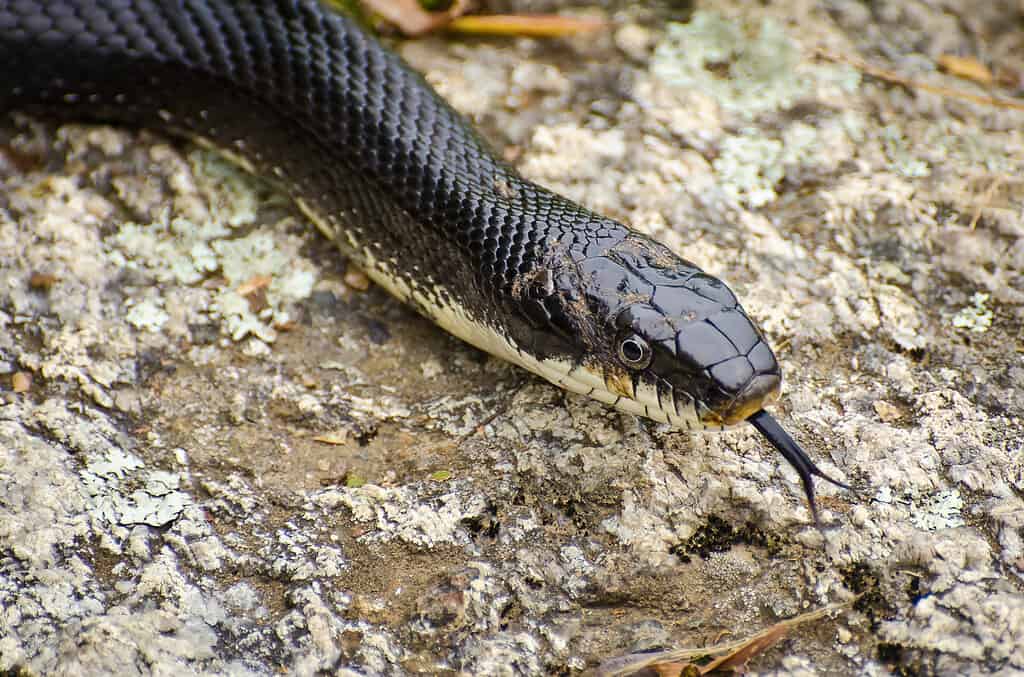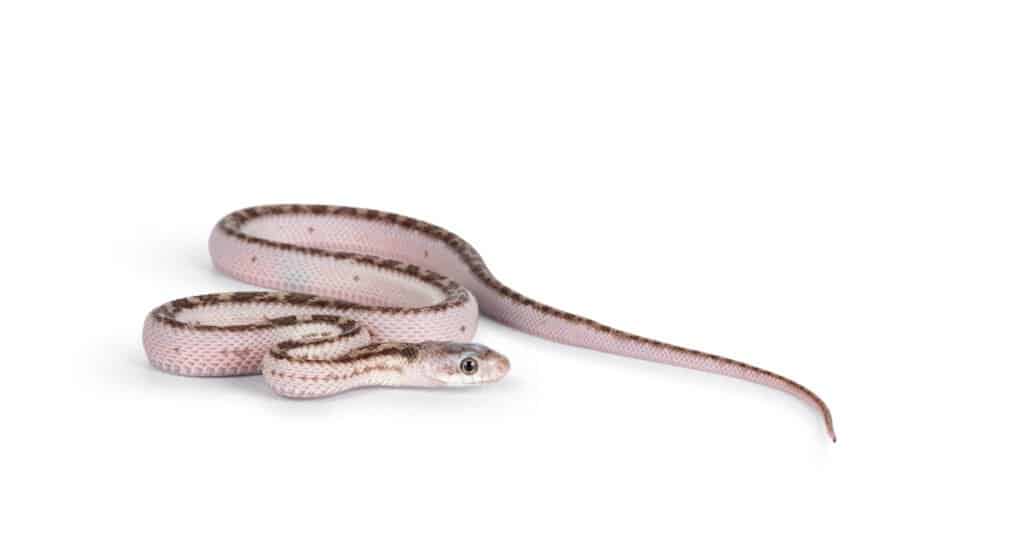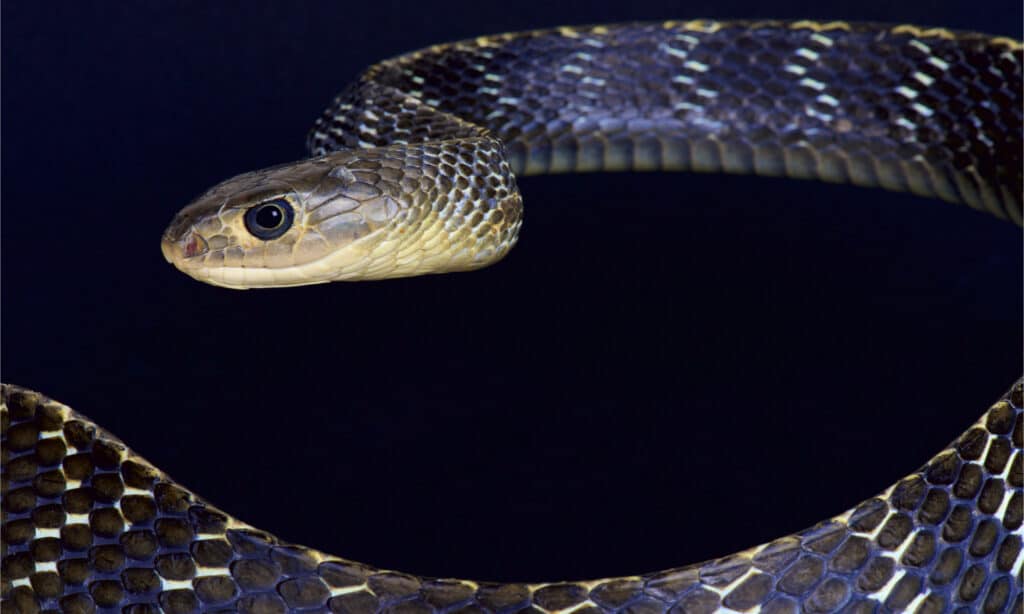Hardy, widespread, and diverse, the many known species of rat snakes can vary in size and overall appearance. But just how big do rat snakes get, and how quickly do they grow? Read on to learn more. We’ll also take a look at the largest rat snake ever recorded, as well as where you might expect to encounter them.
How Many Different Kinds of Rat Snakes Are There?

Eastern black rat snakes
are among the most common rat snake species in North America.
©iStock.com/RCKeller
Taxonomically, a rat snake is any one of around 50 total species of snakes spanning 15 total genera. They are loosely divided into two main groups: old and new world rat snakes. Most better-known species fall under either the Elaphe or Pantherophis genera.
Collectively, rat snakes are constrictors, and most species are non-venomous. However, more recent studies have shown some old-world varieties of rat snakes do possess a very small amount of venom that is mostly harmless to humans.
Thanks to their somewhat large yet still manageable size, fairly docile temperament, and hardy nature, many species are popular pets among reptile hobbyists. Species like the eastern black rat snake and the corn snake are among the most widespread varieties kept as pets.
As their collective common name implies, rat snakes mainly eat small-to-medium-sized rodents like mice, rats, and moles. However, they also aren’t picky eaters and will feed on many species of small birds and their eggs, reptiles, amphibians like lizards and frogs, and even insects.
How Big Are Baby Rat Snakes?

Baby rat snakes like this
Texas white-sided rat snake
are around a foot long upon hatching.
©Nynke van Holten/Shutterstock.com
Upon hatching and entering the world for the first time, most varieties of baby rat snakes are around 10 to 15 inches long. At this stage in their lives, they usually weigh just five to ten grams or so. They hatch in clutches of anywhere from half a dozen to around two dozen eggs. Their eggs are only around two inches long and are off-white and oblong in appearance. The shells, like those of most snakes, are soft and leathery.
After emerging from brumation in the winter, rat snakes typically enter a breeding season that lasts from early-to-mid spring to early-to-mid-summer. Depending on the exact species, a female rat snake may choose to nest and lay her eggs in a variety of different locations. Generally, most opt for somewhere warm, dark, and protected, like under stumps, inside hollow logs or abandoned burrows, or under piles of leaf litter.
After developing for roughly four to seven weeks, the young hatch from their eggs and get very little intervention from their parents. Because rat snake young are so vulnerable, they often become prey for various carnivorous and omnivorous mammals and birds like raccoons, foxes, and hawks.
How Big Do Fully-Grown Rat Snakes Get?
Rat snakes grow very quickly as juveniles, with their length and weight doubling just a few short weeks into their lifespan. Despite being small and quite vulnerable to many predators during this life stage, they are ravenous eaters and become skilled hunters in their own right very quickly. In general, most rat snake species take around three to four years to reach adulthood and become sexually mature.
Upon reaching early adulthood, most species of rat snakes are around four to seven feet long. As fairly heavy-bodied, bulky constrictor snakes, they weigh anywhere from 1.5 to 6 pounds. Much of this weight is the muscle used for constricting prey like mice and rats.
While most species of rat snakes max out at around five to six feet in length, they can continue to grow well into their adult years. Particularly large specimens can reach seven to nine feet long, with especially large varieties like the keeled rat snake being capable of reaching nearly ten feet in length. In terms of weight, they can also continue putting on bulk as adults, with some eventually weighing nearly ten pounds when fully grown.
Rat Snake Size Estimates At a Glance: Growth Chart
| Approximate Age | Length | Weight |
| Hatchling | 10-16 inches | 5 to 10 grams |
| Juvenile (Under 1 year old) | 16 to 36 inches | 0.5 to 1.0 pounds |
| Sub-Adult (1-3 years old) | Three to five feet | 1.0 to 5.0 pounds |
| Adult (3+ years old) | Four to seven feet | 1.5 to 6 pounds |
What is the Largest Rat Snake Ever Recorded?

Keeled rat snakes are among the largest rat snake species and can reach more than 10 feet long.
©reptiles4all/Shutterstock.com
Incredibly, the largest rat snake ever recorded measured an impressive 13 feet and one inch in length. It was a keeled rat snake, which is among the largest varieties of rat snakes. Most keeled rat snakes measure around 4 to 9 feet long when fully grown, with especially large individuals sometimes exceeding 10 feet.
The specimen was documented in 2015 by Indraneil Das, a conservation biologist at Universiti Malaysia Sarawak in Kota Samarahan, Sarawak, Malaysia. In a book he published titled “Field Guide to the Reptiles of South-East Asia,” he detailed the record-breaking specimen measurements.
This particular individual’s weight was not recorded, but it likely weighed well over 10 pounds if we consider its length and the average rat snake growth rates and estimates listed above. Also, as we touched on earlier, rat snakes are quite bulky and muscular snakes, as they rely on constriction to take down their prey and are largely non-venomous.
Places You’re Most Likely to Encounter Rat Snakes
Wondering where you might be most likely to encounter rat snakes? Well, if you live in the northern hemisphere, the answer to that question is just about anywhere! As an incredibly widespread and hardy bunch of snakes that make up more than 50 species and span 15 genera, rat snakes can be found throughout much of North America, eastern and western Europe, and much of Asia. However, many species are also able to live in parts of Central America.
More specifically, though, rat snakes are very adaptable and can thrive in a range of habitats. Some varieties live in humid rainforests and swamps, while others reside in drier, flatter environments like scrublands, temperate forests, and fields. Like most snakes and reptiles in general, they like it warm and moderately humid, though during brumation they can withstand cold, near-freezing winter temperatures and drier conditions.
If you live in the States, the most widespread varieties of wild rat snakes are eastern and western black rat snakes, as well as corn snakes. These species can be found throughout much of North America in similarly widely varying habitats like farmlands, forests, and wetlands, and they’re being found in increasingly more urban areas as of late.
If you encounter a rat snake, the best course of action is to simply leave the animal and back away slowly. Fortunately, like most snakes, virtually all rat snake species are non-aggressive towards humans. Additionally, they are mostly non-venomous or possess a very small, harmless amount of venom. Furthermore, they are beneficial, as they eat large numbers of pest animals like rodents that would otherwise become overpopulated and offset entire ecosystems.
The photo featured at the top of this post is © Ryan M. Bolton/Shutterstock.com
Discover the "Monster" Snake 5X Bigger than an Anaconda
Every day A-Z Animals sends out some of the most incredible facts in the world from our free newsletter. Want to discover the 10 most beautiful snakes in the world, a "snake island" where you're never more than 3 feet from danger, or a "monster" snake 5X larger than an anaconda? Then sign up right now and you'll start receiving our daily newsletter absolutely free.
Thank you for reading! Have some feedback for us? Contact the AZ Animals editorial team.







